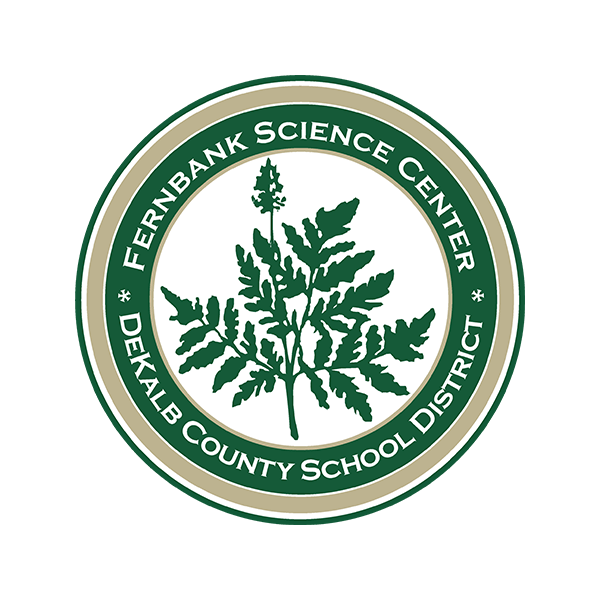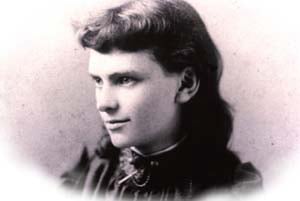
Fernbank: A Short History
By James A. Mackay, Trustee Emeritus Fernbank, Inc.

By James A. Mackay, Trustee Emeritus Fernbank, Inc.
On December 3, 4 and 5, 1967, when we gathered to celebrate the opening of Fernbank Science Center, we assembled as what should be called the "Fernbank family" to celebrate a momentous advance for the "Fernbank idea." The source of the Fernbank idea and spirit, Miss Emily Harrison (pictured below), was present and experienced what few great dreamers have enjoyed: the realization of her dream in her lifetime. As she stood up beaming with joy, she received a thunderous and prolonged ovation. Fifty years before that occasion, after attending her brother's graduation from the University of the South in its vernal setting, she wrote her parents as follows:
"These heartstrings of ours have a curious way of getting tangled up in things: particular trees and rocks and hill slopes ... but gradually I had come to feel that Fernbank was too big and too beautiful for one family's consumption ... The best thing to do with it would be to put it into the lives of children"

Twenty-one years later, in 1938, after her father's death and at the time she had secured the agreement of her siblings to sell the property to a corporation organized to save the core property of 70 acres, she wrote a friend, Tom Glenn, regarding her "school-in-the-woods" and remarked that "twenty years is a long time to hold on to a dream, but if the dream is good enough, it holds you." Miss Emily's dream was good enough!
Men, women and children, organizations and governing authorities have been possessed by Miss Emily's dream. Any history of the Fernbank idea and spirit must necessarily find its roots in Miss Emily's mind and soul, in her tenacity, her capacity to teach us that life is a trust and that, as Simone Weil has said, "The natural world is God's Language to humankind."
Miss Emily would modestly deny that she accomplished this alone. What she did was to persuade her parents, her siblings, the original purchasers of the seventy-acre tract, the original incorporators, directors (and later, trustees), teachers, garden club members, boys and girls, Girl Scout, Campfire, and YMCA leaders that their time had come to make her dream a reality, to protect and preserve the forest and eventually establish a teaching facility by whatever means, public or private.
The original Directors purchased the seventy acres for $35,000 or $500 an acre. It is fair to say that the property is now worth $35,000 per acre. As in the parable of the talents the original benefactors invested wisely and the yield has been great and to the core property another 50 acres have been added. The year following the purchase of the property, the Directors amended their charter for a corporation for profit to convert it to a non-profit corporation. They became Trustees.
In 1939 the Trustees had accepted the responsibility to hold the property in perpetuity and to see that it was used for the education of children. The Trustees could not have anticipated the pressures that would come to threaten the very survival of the property. After all, the property was at the edge of Druid Hills; war clouds had put a brake on residential development. The population of DeKalb County, according to the 1940 census, was not yet 87,000 . There were no apparent encroachments and World War II stalled many activities that might present a problem.
No one would have believed that by 1960 the census would show a DeKalb population of 256,000 and by 1992 an estimated half million growth since 1940. As for Miss Emily's "school-in-the-woods" for educating children, in 1939 such a school was nowhere in sight. World War II had directed such idealist purposes and energies elsewhere.
With the victorious end of World War II, pressures on the core property mounted demands for residential development with all the attendant needs for land, roads, water and sewers, schools, and shopping centers. In the late forties Chairman Guy Woolford employed Thomas O. Davies and me to work out an exchange of property with the developer of Artwood Road so as to protect the forest. It rapidly became apparent that the forest could become "unraveled" if a close watch was not maintained and if key adjacent properties and other pieces of property were not acquired. The Trustees did a good job on both counts although the property was in dire need of fencing. There was no money and the Trustees had no employees. The Trustees did their best against heavy odds to preserve the forest. And they did not neglect the children of those years, or the adults. The Atlanta Journal, The Atlanta Constitution, and the local weeklies, gave much space and attention from 1939 on to this unique asset of the Atlanta region and this attracted interest and attendance from the public and private schools of the area, Girl Scouts, Boy Scouts, Campfire Girls, YMCA and YWCA, day campers, and many other groups. The Girl Scouts had an active day camp program in the forest for thirty-two years, from 1934 through 1966. Most of these groups were under competent leaders and instructors but, even so, intensive use in some areas resulted in clearing of small trees and raking the fragile forest floor.
The 1950s saw plenty of interest and activity on the positive side and increasing threats to the survival of the forest on the negative side. The Trustees offered the property for management to Emory University, Agnes Scott College, the City of Decatur and others. There were no takers and understandably so: there were no precedents; the task was complex; and the cost would be formidable. Meanwhile, Miss Emily and Dr. Baker kept reminding us to work harder to protect the forest and get on with environmental education.
Three decisive individuals emerged: Dr. Robert B. Platt, Superintendent Jim Cherry, and Chairman W. A. Horne, Jr. Of course, there were many others, but these three put it together. Dr. Platt had become head of the Biology Department of Emory, a worthy successor to Dr. W. B. Baker. Bob was a renaissance man. The rest of us were struggling with frustration and confusion.
Bob cut through all this and saw the possibilities for science education. Superintendent Cherry, perhaps one of the finest administrators in the history of public education in Georgia, also saw the possibilities for enhancing the curriculum of DeKalb's and Georgia's public and private schools. Each reinforced the other. Chairman William A. Horne, Jr., was the other right person at the right place at the right time. Bill was like a Patton tank (he was on General Patton's staff). He was slow to get started but when he got going, you could not stop him, and nobody did. Any one of these three could have begged off for acceptable reasons: Dr. Platt, for academic commitments; Superintendent Cherry for pressures of growth and social change; Chairman Horne for heavy business pressures. But, by 1965 a splendid team had been put together. There was clarity of vision and unity of effort. The result was the fencing and leasing of the forest, the construction of trails, the building of the Science Center with its planetarium, the 36" telescope, the electron microscope, the exhibit halls, the classrooms, the extension programs. And the result for the Trustees was the satisfaction in seeing the forest protected as never before and, through brilliant organization and administration, the finest teaching tool of its kind anywhere - not my opinion, but that of a high official of the Smithsonian who knows what there is in this country and elsewhere in the world!
Offline Website Software